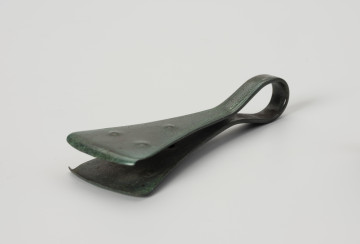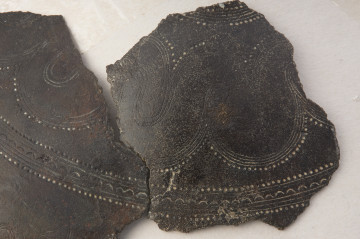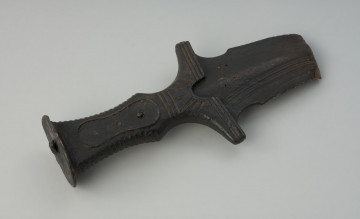
Tweezers
około 900 p.n.e. — 750 p.n.e.
National Museum in Szczecin
Part of the collection: Bronze Age
The clay vessel has the form of a two-handled amphora with a convex belly and a relatively short conical neck. Its handles are decorated with channels or grooves, also known as fluting. At the base of the neck is a circumferential band made up of three grooved lines. A band of grooves made using a similar technique, forming a wavy line, decorates the lower part of the belly. Above its bend, there is a single wavy line surrounded by small points. The circular shape combined with the rich decoration makes it grand and unique. The uniform dark grey colour indicates that the vessel has been carefully fired in a reducing atmosphere, i.e. without oxygen. It is undoubtedly an expression of the craftsmanship of the prehistoric potters. The relic was accidentally discovered in 1940 by Johanes Pacull at the top of a large hill known as Postbergen – now Bombardier Hill near the Szczecin Żydwoce-Klucz housing development. It was transferred to the Pommersches Landesmuseum in Szczecin (1927-1945), as evidenced by the inventory markings of the museums of the time. The amphora, which can be associated with the earlier Bronze Age periods, i.e. the years around 1100-750 BC, was found in one of the graves in an inhumation burial ground of the Lusatian culture. In a grave without a stone enclosure, it acted as an urn. In addition, it is known that it was covered by a small flat stone and co-existed with a red-coloured clay vessel. Dorota Kozłowska
Author / creator
Object type
amphora, funerary vessel, ritual object
Technique
modelling, reduction firing
Material
ceramic
Origin / acquisition method
acquisition
Creation time / dating
Creation / finding place
Owner
Muzeum Narodowe w Szczecinie
Identification number
Location / status

około 900 p.n.e. — 750 p.n.e.
National Museum in Szczecin

around 900 p.n.e. — 750 p.n.e.
National Museum in Szczecin

around 900 p.n.e. — 750 p.n.e.
National Museum in Szczecin
DISCOVER this TOPIC
National Museum in Lublin
DISCOVER this PATH
Educational path